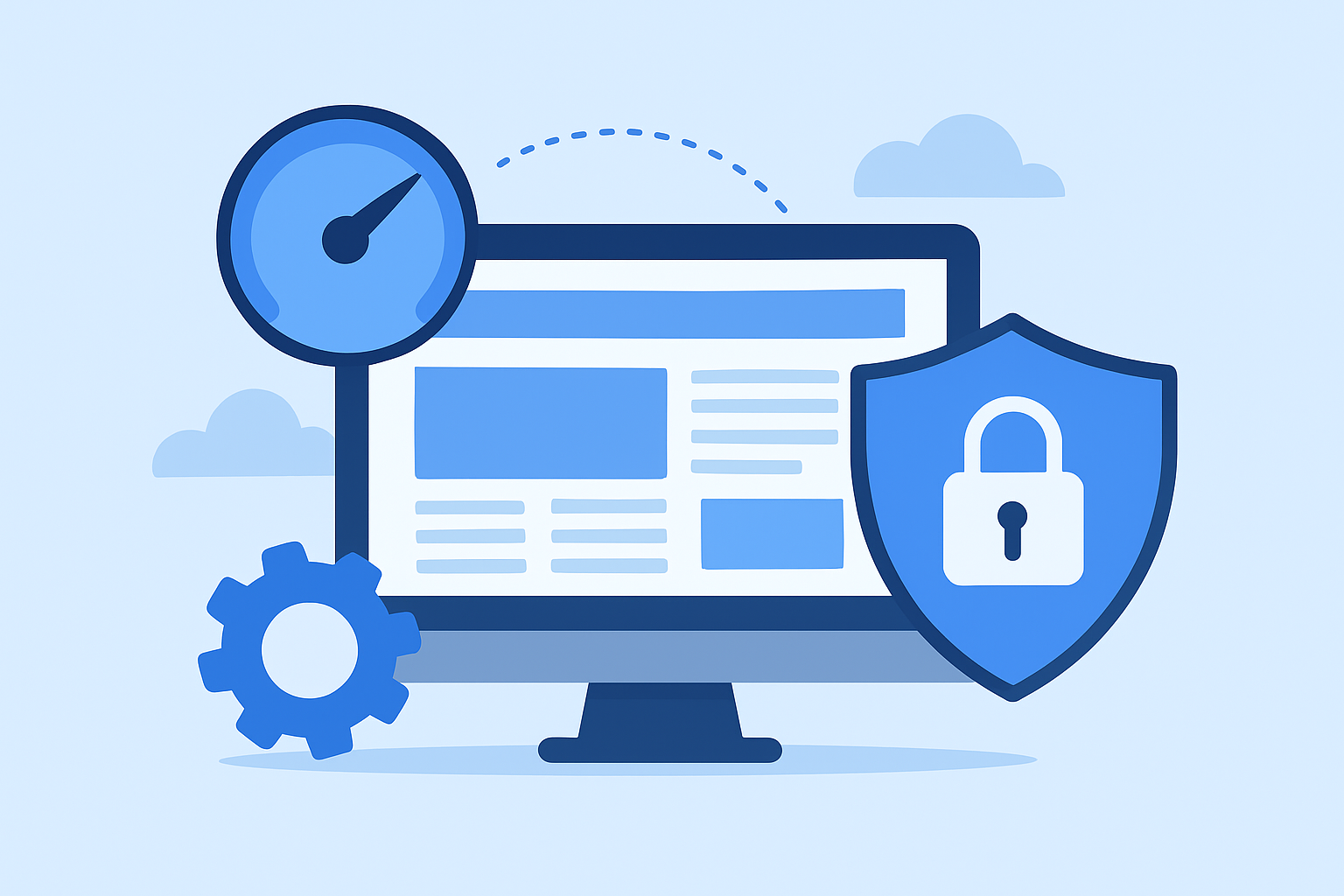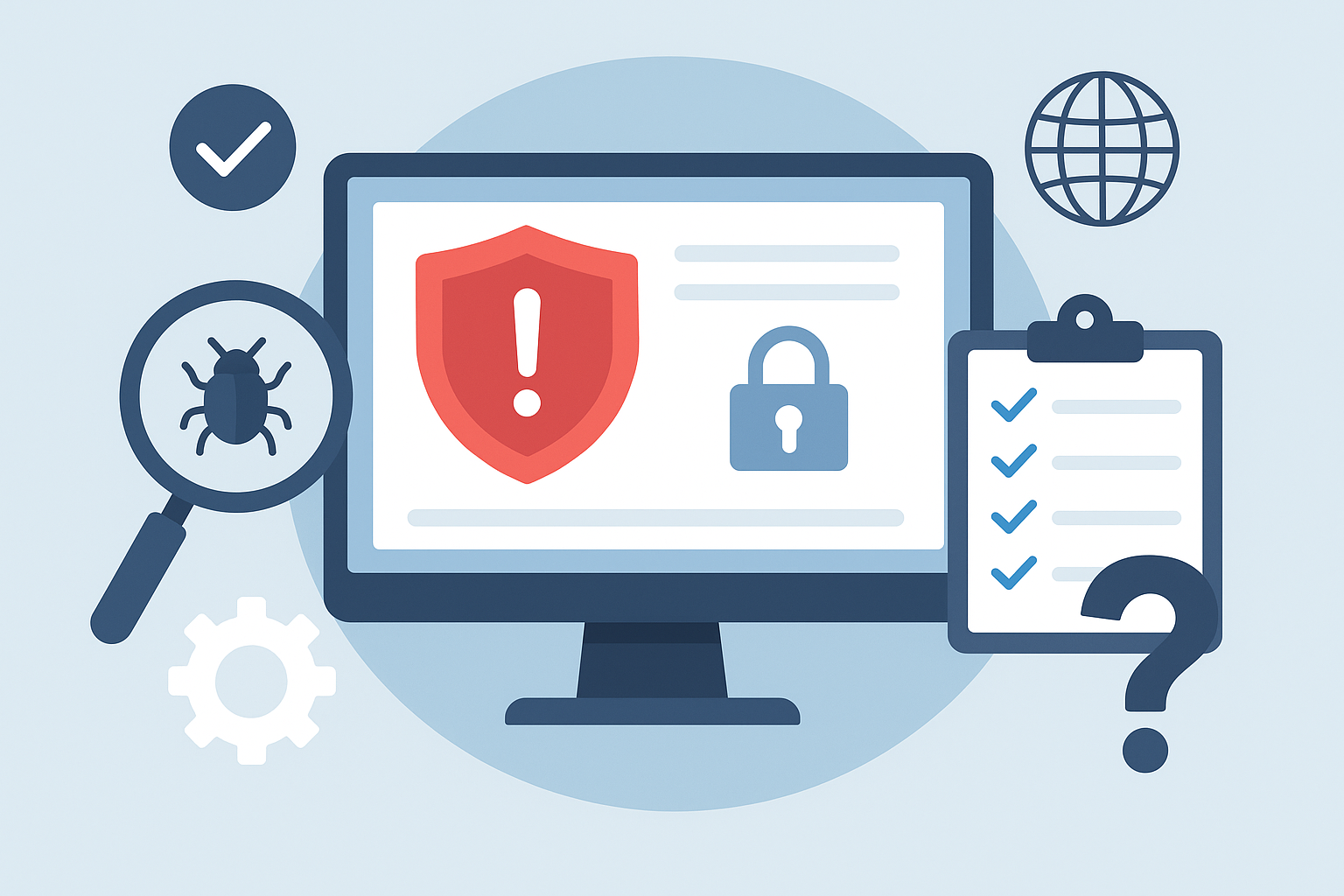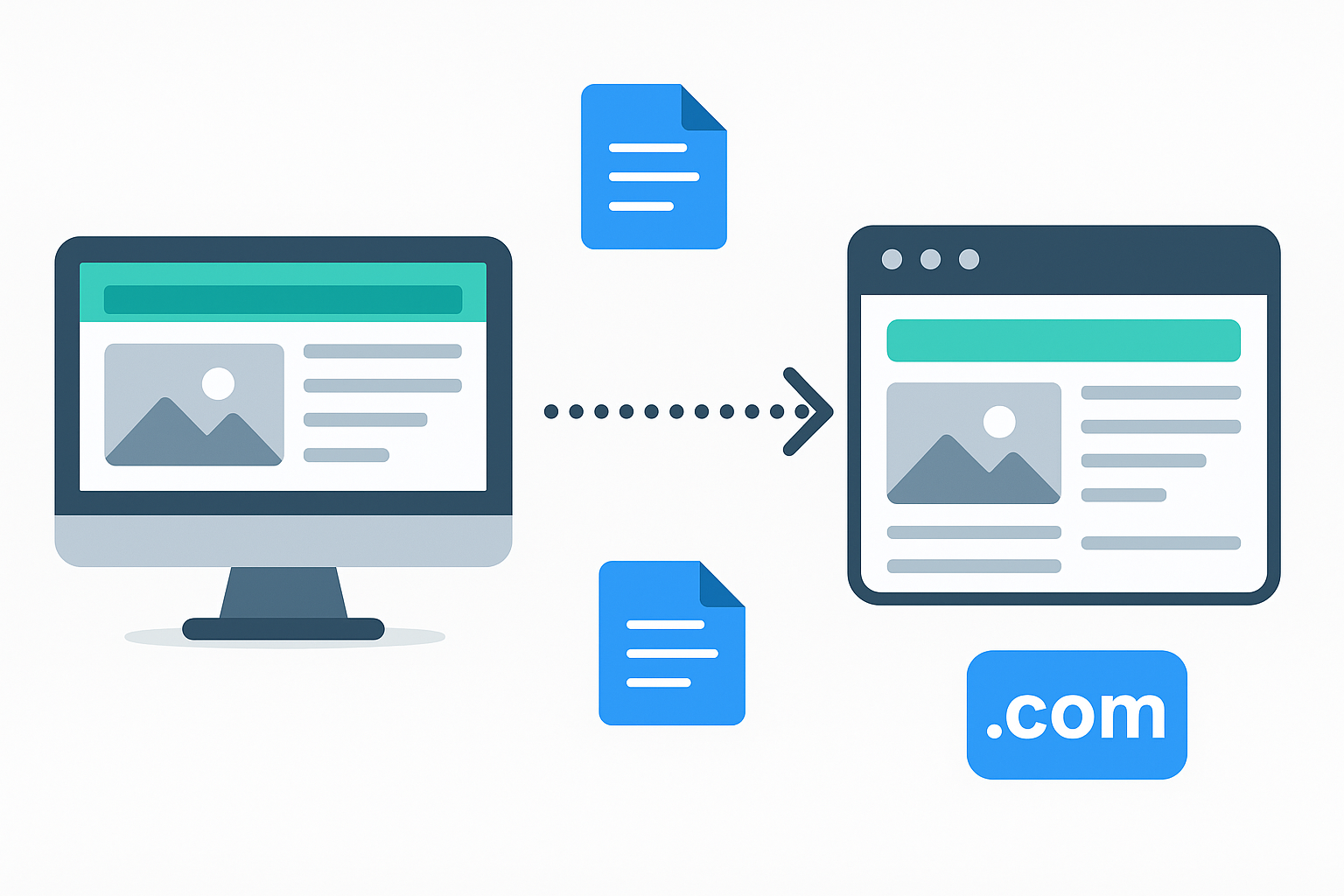In today’s digital landscape, Website Speed and Security Optimization play a critical role in determining online success. A fast, secure, and efficient website not only enhances user experience but also builds trust and credibility with visitors. When your website loads quickly and stays protected from cyber threats, users are more likely to engage, convert, and return. Businesses that neglect optimization often face performance issues, security breaches, and SEO penalties. By prioritizing Website Speed and Security Optimization, you can boost search rankings, improve customer satisfaction, and ensure long-term digital stability in a competitive environment.
Introduction
In the modern web environment, speed and security are no longer optional — they’re the foundation of a successful digital presence. A slow or vulnerable website can destroy user trust within seconds, leading to lost revenue and damaged brand reputation. Visitors expect instant page loading and secure browsing experiences, and search engines reward websites that deliver both. At FixHackedSite, we understand the intricate relationship between performance and protection. We specialize in helping website owners strengthen their digital foundations by combining speed optimization techniques with robust security measures.
Your website’s performance directly affects visibility, conversions, and long-term growth. A well-optimized site not only attracts search traffic but also reduces bounce rates and enhances user engagement. Meanwhile, advanced security protocols safeguard user data and prevent cyber-attacks that can cripple your online business. The process of Website Speed and Security Optimization involves continuous monitoring, fine-tuning, and updating of your site to meet ever-evolving web standards.
This blog will take a deep dive into the critical aspects of optimizing your website for both speed and security. You’ll discover how to improve loading times, protect sensitive information, and maintain optimal site performance across all devices. From caching and compression to SSL certificates and malware protection, we’ll cover every essential element that ensures your website remains fast, reliable, and safe.
The Importance of Website Speed in Today’s Digital World
Speed determines how users perceive your brand and how effectively your website converts visitors into customers. In a world where every second counts, a delay of even a few milliseconds can drastically affect engagement and sales. Studies show that users abandon websites that take longer than three seconds to load, highlighting the direct link between site speed and user retention. The faster your pages load, the more likely visitors will stay, explore, and interact with your content — leading to higher conversions and revenue.
A fast-loading website also improves your ranking on search engines. Google considers page speed as one of its top ranking factors, which means that optimizing for speed directly enhances your SEO efforts. Additionally, mobile-first indexing has made speed optimization even more vital for achieving visibility. Whether users are accessing your website on smartphones, tablets, or desktops, quick loading times ensure a seamless experience across devices.
Moreover, a slow site can frustrate visitors and give competitors an advantage. Users today demand immediate results and frictionless browsing experiences. If your website doesn’t meet those expectations, they’ll move to another platform. Therefore, investing in speed optimization isn’t just about aesthetics or performance — it’s about creating a user experience that builds trust and encourages loyalty over time.
Understanding the Connection Between Speed and Security
While speed and security might seem like separate concerns, they are deeply interconnected. A secure website often performs faster because it operates efficiently, free from malicious code or vulnerabilities. When malware infiltrates a website, it can slow down page loading times by injecting harmful scripts, hijacking server resources, or redirecting visitors to unsafe pages. Conversely, optimizing for speed often requires strengthening the site’s infrastructure, which in turn enhances overall security.
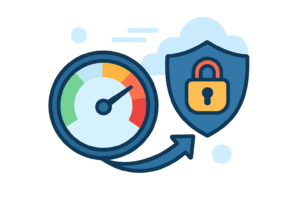 For example, implementing SSL (Secure Socket Layer) encryption not only protects user data but also boosts performance through the use of HTTP/2, which improves data transfer speed. Similarly, using content delivery networks (CDNs) enhances both security and speed by distributing website content across multiple servers worldwide, reducing latency while defending against DDoS attacks. These integrated improvements make your website faster, safer, and more reliable for users globally.
For example, implementing SSL (Secure Socket Layer) encryption not only protects user data but also boosts performance through the use of HTTP/2, which improves data transfer speed. Similarly, using content delivery networks (CDNs) enhances both security and speed by distributing website content across multiple servers worldwide, reducing latency while defending against DDoS attacks. These integrated improvements make your website faster, safer, and more reliable for users globally.
In essence, security and speed reinforce each other. When your site is well-secured, it performs optimally because there are fewer risks of interference, downtime, or malicious slowdowns. Likewise, a speedy website tends to have better resource management and structured code — qualities that naturally improve resilience against cyber threats. By treating Website Speed and Security Optimization as a unified goal, you can ensure a seamless experience that’s both efficient and protected.
How Website Speed Affects User Experience and SEO
User experience is directly tied to website speed. Visitors judge the professionalism and reliability of a website within seconds, and a sluggish page creates frustration. Fast-loading pages make users feel valued, respected, and more inclined to explore additional sections of your website. A good user experience encourages visitors to stay longer, increasing dwell time and engagement metrics — both of which influence search engine rankings.
Search engines like Google continuously refine their algorithms to reward sites that deliver exceptional user experiences. Core Web Vitals, such as Largest Contentful Paint (LCP) and First Input Delay (FID), measure how quickly users can see and interact with your content. Websites that perform poorly in these metrics are penalized in search rankings, reducing visibility and traffic. Optimizing for speed helps you meet these criteria, resulting in better organic reach and improved brand credibility.
Moreover, in today’s mobile-first era, speed optimization is non-negotiable. Mobile users expect lightning-fast load times even on slower networks. If your site lags, potential customers will abandon it and move on to competitors. By focusing on performance, you ensure that your website delivers a consistent and smooth experience across all devices — a key factor in both retaining users and climbing search engine results pages.
The Role of Hosting in Website Speed and Security
Your hosting environment is the foundation of your website’s performance and protection. A low-quality hosting provider can severely limit your website’s loading speed, uptime, and security. On the other hand, a reliable host ensures that your site runs efficiently and stays protected against cyber threats. Website Speed and Security Optimization starts with choosing a hosting solution that offers fast servers, optimized resources, and strong security infrastructure. Features like SSD storage, HTTP/2 support, and high bandwidth allocation can make a huge difference in how your website performs for users around the world.
When selecting a web host, it’s important to consider not just performance but also data protection measures. Many top-tier hosts now include integrated firewalls, malware scanning, and DDoS protection within their hosting packages. These measures prevent malicious attacks that can slow down or crash your website. Additionally, server-level caching, automatic backups, and uptime monitoring ensure that your site remains both fast and reliable even during peak traffic hours. A secure hosting environment provides peace of mind, knowing your data and visitors are safe.
Furthermore, hosting affects how search engines evaluate your site’s credibility. Downtime, slow response times, or unsecure connections can harm your SEO rankings and reduce user trust. Migrating to a managed or dedicated hosting service can significantly improve performance and safeguard sensitive data. Ultimately, your web hosting provider is your first line of defense and the backbone of your speed and security strategy. Choosing wisely sets the stage for long-term success and ensures that your site runs smoothly, securely, and efficiently.
How Caching and Compression Improve Load Time
Caching and compression are two of the most powerful techniques for Website Speed and Security Optimization. Caching involves storing copies of your website’s files so that browsers can load them quickly without repeatedly requesting data from the server. This process dramatically reduces page load time for returning visitors. There are various types of caching — browser caching, server caching, and CDN caching — all working together to optimize delivery and reduce latency. When implemented correctly, caching can make your website feel almost instantaneous to users.
Compression, on the other hand, minimizes the size of your website’s files before sending them to the user’s browser. Tools like GZIP and Brotli are commonly used to compress HTML, CSS, and JavaScript files, reducing their size by up to 70%. Smaller file sizes mean faster data transfer, which leads to quicker load times and less server strain. This not only improves user experience but also lowers hosting bandwidth costs. Fast-loading websites tend to perform better on search engines, reinforcing the connection between optimization and visibility.
Together, caching and compression form the backbone of front-end performance optimization. When pages load quickly and smoothly, users are more likely to engage and stay longer. Moreover, by reducing the number of server requests, these techniques also contribute indirectly to security by limiting exposure points for potential attacks. Therefore, implementing caching and compression isn’t just about speed — it’s a key step in maintaining a stable, secure, and efficient online presence.
The Power of Content Delivery Networks (CDNs)
A Content Delivery Network (CDN) is one of the most effective tools for enhancing both speed and security. A CDN works by distributing copies of your website’s files across multiple servers located in different geographical regions. When a user accesses your site, the CDN delivers content from the server nearest to them, reducing latency and speeding up page load times. This global distribution ensures that no single server is overloaded, providing a seamless experience for users everywhere.
In addition to speed, CDNs offer strong security advantages. Many CDN providers integrate DDoS protection, web application firewalls (WAFs), and bot management systems. These features detect and block malicious traffic before it reaches your main server, protecting your website from common attacks. Furthermore, CDNs mask your origin server’s IP address, adding an extra layer of protection against direct intrusion attempts. The combination of faster delivery and advanced security makes CDNs essential for Website Speed and Security Optimization.
By using a CDN, businesses can handle large traffic volumes without performance issues. Websites that rely solely on a single hosting server are more vulnerable to overloads and attacks. With a CDN, even if one server goes down, others automatically take over, ensuring uptime and reliability. In today’s globalized internet environment, implementing a CDN is a crucial step toward building a high-performing, resilient, and secure website that meets both user expectations and SEO standards.
Minimizing Code and Optimizing Resources
Clean, efficient code is at the heart of any high-performing website. Excessive or poorly written code can slow down loading times, increase server requests, and create vulnerabilities that hackers might exploit. By minimizing and optimizing code, you can significantly improve site performance and reduce potential risks. Website Speed and Security Optimization requires ongoing attention to how your HTML, CSS, and JavaScript are structured. Developers often use minification tools that remove unnecessary characters, spaces, and comments from code without affecting its functionality. This reduces file sizes and enhances page speed.
Resource optimization goes beyond code cleanup. It includes optimizing images, leveraging lazy loading, and minimizing HTTP requests. High-resolution images are essential for visual appeal but can drastically affect performance if not properly compressed. Using modern image formats like WebP and AVIF allows websites to retain quality while reducing file size. Similarly, lazy loading ensures that images and videos load only when users scroll to them, conserving bandwidth and improving perceived speed. This technique also reduces the initial page load time, creating a smoother user experience.
From a security standpoint, optimizing resources reduces exposure to vulnerabilities. Fewer external scripts mean fewer potential entry points for attackers. Outdated plugins or unoptimized code can introduce risks, while streamlined, up-to-date scripts minimize these issues. Maintaining optimized code and resources not only enhances performance but also strengthens website security. Together, these improvements make your website leaner, faster, and far more resilient to threats.
The Importance of HTTPS and SSL Certificates
In the digital age, users expect websites to be safe and trustworthy. One of the most effective ways to build this trust is by using HTTPS and SSL certificates. When a website operates over HTTPS, it encrypts the data exchanged between the user’s browser and the server, protecting sensitive information such as passwords, credit card details, and personal data. This encryption prevents hackers from intercepting or tampering with the data, ensuring user privacy. Implementing SSL (Secure Socket Layer) certificates is not only a standard security measure but also a critical component of Website Speed and Security Optimization.
Beyond security, HTTPS also plays an important role in website performance. Modern browsers and search engines prioritize HTTPS-enabled websites, improving their SEO rankings. Furthermore, enabling HTTPS allows sites to take advantage of HTTP/2 technology, which enhances page loading speed through multiplexing and header compression. In other words, your website becomes faster and more efficient simply by switching to a secure protocol. This dual benefit of improved security and speed makes HTTPS essential for any professional or business website.
Additionally, displaying a padlock symbol in the address bar boosts user confidence and reduces bounce rates. Visitors are more likely to engage with and purchase from sites that display clear security indicators. On the other hand, websites without HTTPS are flagged as “Not Secure” by browsers, instantly discouraging potential customers. Therefore, integrating SSL certificates is no longer optional — it’s a necessity. A secure website protects users, improves search rankings, and enhances overall site performance, forming the cornerstone of Website Speed and Security Optimization.
Optimizing Images for Faster Website Performance
Images play a major role in both website design and user engagement, but they can also be the leading cause of slow load times. High-resolution images that are not properly optimized can overload servers and frustrate users. To achieve effective Website Speed and Security Optimization, image optimization should be a top priority. This process involves reducing the file size of images without compromising their visual quality. Using tools such as TinyPNG, ImageOptim, or built-in CMS compression features can help reduce file sizes significantly, allowing pages to load faster while maintaining a professional appearance.
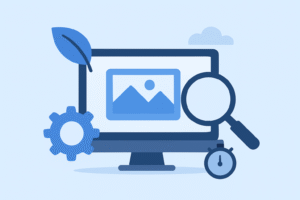 Moreover, adopting modern image formats like WebP and AVIF can further enhance speed. These formats provide superior compression compared to traditional JPEG or PNG, offering the same quality at smaller sizes. Combining these formats with lazy loading ensures that images only load when a user scrolls to them, saving bandwidth and improving initial load time. Additionally, using responsive images that automatically adjust to screen size prevents unnecessary data transfer on mobile devices, resulting in faster mobile performance and reduced bounce rates.
Moreover, adopting modern image formats like WebP and AVIF can further enhance speed. These formats provide superior compression compared to traditional JPEG or PNG, offering the same quality at smaller sizes. Combining these formats with lazy loading ensures that images only load when a user scrolls to them, saving bandwidth and improving initial load time. Additionally, using responsive images that automatically adjust to screen size prevents unnecessary data transfer on mobile devices, resulting in faster mobile performance and reduced bounce rates.
From a security perspective, optimizing images can help prevent vulnerabilities that arise from unverified image uploads. Large, uncompressed files increase server load and can even be exploited to deliver malicious code if not properly sanitized. Regularly scanning uploaded files and using secure image management plugins helps mitigate these risks. When optimized correctly, images enhance the aesthetics of your website while maintaining top-tier performance and protection — a vital combination in Website Speed and Security Optimization.
The Role of Database Optimization in Site Speed
Behind every dynamic website lies a database that stores essential content, settings, and user information. Over time, this database can become bloated with unnecessary data such as revisions, spam comments, and expired sessions, slowing down website performance. Website Speed and Security Optimization requires regular database maintenance to ensure quick data retrieval and stable performance. By cleaning up redundant data and optimizing database tables, websites can load faster and operate more efficiently.
Using database optimization tools like phpMyAdmin or WP-Optimize (for WordPress sites) makes this process seamless. These tools remove unnecessary entries, repair corrupted tables, and defragment the database for smoother operation. Regular optimization ensures that queries execute faster, reducing server load and improving response times. When users interact with your site — such as submitting a form or browsing a product catalog — an optimized database processes those requests instantly, creating a seamless browsing experience that encourages engagement.
From a security standpoint, database optimization also strengthens protection. Outdated data or unused tables can become vulnerable to SQL injection attacks if left unattended. Regular database cleanup helps close these security gaps. Additionally, using strong passwords, limiting database access, and implementing regular backups further enhances data integrity. A well-maintained database ensures your website remains fast, stable, and secure, ultimately supporting both user satisfaction and SEO success.
Protecting Against Malware and Hacking Attempts
A website’s security is only as strong as its ability to defend against malware and hacking attempts. Hackers often target websites with weak security to inject malicious scripts, steal data, or redirect visitors to fraudulent pages. These attacks not only damage reputation but can also severely slow down your site. Website Speed and Security Optimization involves proactive defense measures to detect and neutralize threats before they cause harm. Implementing real-time malware scanning, intrusion detection systems, and firewalls helps identify and block suspicious activities at the earliest stage.
Regular updates are another critical part of protecting your website. Outdated CMS platforms, themes, or plugins often contain vulnerabilities that attackers exploit. Keeping everything up to date ensures your website runs on the latest, most secure versions. In addition, two-factor authentication (2FA), strong password policies, and user role restrictions prevent unauthorized access to sensitive areas of your site. Security plugins such as Wordfence, Sucuri, or iThemes Security provide layered defense and automatic notifications for potential breaches.
Beyond preventing attacks, maintaining a secure website also enhances speed and reliability. Malware infections often slow down websites by running hidden background processes or generating unnecessary server requests. Cleaning infected files and removing malicious code restores performance and prevents future compromise. By investing in robust malware protection and continuous monitoring, you ensure that your website remains both fast and secure — a core goal of Website Speed and Security Optimization.
The Role of Regular Updates in Maintaining Speed and Security
Regular updates are one of the simplest yet most powerful aspects of Website Speed and Security Optimization. Every CMS (Content Management System), plugin, or theme undergoes periodic updates to improve functionality, patch vulnerabilities, and enhance performance. Failing to update these components leaves your website exposed to cyber threats and performance issues. Developers often release updates specifically to address discovered bugs and security flaws, so applying these updates ensures that your website remains fast, efficient, and safe from exploitation.
From a performance standpoint, updates frequently include code optimizations that improve page loading times and compatibility with newer technologies. Outdated components can conflict with modern browsers, leading to slow performance, broken layouts, or even site crashes. Regular updates keep your site running smoothly, ensuring visitors experience seamless navigation. Furthermore, when your website’s core system and extensions are properly maintained, it reduces server strain and prevents resource overload. The result is a faster, more stable site that performs consistently under varying conditions.
In terms of security, updates play a preventive role. Cybercriminals often scan the internet for outdated software to exploit. By keeping your website up to date, you eliminate potential entry points for these attackers. Additionally, update notifications should never be ignored — scheduling regular maintenance checks helps you apply patches promptly. Pairing updates with routine backups ensures that you can restore your site quickly if anything goes wrong. Staying proactive about updates creates a strong foundation for both speed and protection, aligning perfectly with your overall optimization strategy.
Implementing Firewalls and Intrusion Detection Systems
A firewall acts as the first line of defense between your website and potential attackers. It monitors and filters incoming traffic, blocking malicious requests before they can reach your server. Website Speed and Security Optimization requires a strong firewall system, as it not only prevents unauthorized access but also contributes to performance stability. By blocking harmful bots, spam traffic, and DDoS attempts, firewalls ensure that your server resources are used efficiently, keeping your website fast and responsive for legitimate users.
Intrusion Detection Systems (IDS) add another layer of protection. They continuously monitor your website for suspicious behavior, alerting administrators when anomalies are detected. This early-warning system allows quick action against potential threats, minimizing downtime and preventing damage. When combined with automated security protocols, IDS solutions can even respond in real-time, blocking attacks and isolating infected files instantly. This proactive defense mechanism is critical in maintaining both performance and trust.
Firewalls and intrusion detection work best when configured correctly. A Web Application Firewall (WAF), for instance, can filter traffic based on known attack patterns and IP reputation. Cloud-based WAFs also enhance site speed by caching static content and delivering it faster to users. This dual functionality ensures that your website remains not just protected but also optimized for performance. Incorporating firewalls and IDS solutions is essential to achieving a balanced strategy that safeguards data while maintaining peak speed and reliability.
Mobile Optimization for Speed and Security
With mobile users now surpassing desktop visitors globally, optimizing your website for mobile devices is no longer optional. Website Speed and Security Optimization must include a mobile-first approach that prioritizes lightweight design, responsive layouts, and efficient code. Mobile users often rely on slower networks, making speed optimization critical. Techniques like AMP (Accelerated Mobile Pages), responsive design, and lazy loading ensure that mobile users enjoy fast and smooth browsing experiences without compromising security.
From a technical perspective, minimizing resource-heavy scripts and compressing images tailored for mobile screens can drastically improve load times. Implementing asynchronous loading for JavaScript ensures that critical content appears quickly, even on low bandwidth connections. This not only improves user satisfaction but also reduces bounce rates — a key factor in search engine ranking algorithms. Websites that perform well on mobile devices typically earn higher visibility in search results, driving more organic traffic.
Security on mobile devices is equally important. Mobile users are more vulnerable to phishing and man-in-the-middle attacks, especially when browsing on public Wi-Fi networks. Enforcing HTTPS encryption, using strong authentication measures, and regularly auditing mobile plugins can help protect against these risks. Furthermore, ensuring that mobile versions of your website mirror the security protocols of the desktop site creates consistency across all platforms. By integrating both speed and security into mobile optimization, you deliver a trustworthy and efficient experience to every visitor.
Monitoring Performance and Security in Real-Time
Continuous monitoring is the key to sustaining long-term Website Speed and Security Optimization. Real-time monitoring tools track both performance metrics and potential threats, allowing website owners to respond quickly before minor issues escalate into serious problems. Platforms like Google PageSpeed Insights, GTmetrix, and Pingdom provide detailed insights into how your site performs across different devices and networks. Regularly analyzing these reports helps identify slow-loading elements, server response delays, and optimization opportunities.
For security, monitoring solutions such as Sucuri, Cloudflare, and Wordfence provide round-the-clock surveillance against malware infections, brute-force attacks, and suspicious login attempts. These tools issue instant alerts when anomalies occur, giving administrators the chance to act immediately. Real-time monitoring also ensures uptime consistency — if your website goes offline due to an attack or technical glitch, notifications are sent right away so corrective measures can be taken. This responsiveness minimizes downtime and preserves your brand reputation.
By integrating automated performance and security monitoring, you create a self-sustaining system that continuously evaluates your website’s health. It’s not just about identifying problems but also about maintaining long-term efficiency. Regular reports and analytics empower you to make informed decisions about future improvements. Monitoring ensures that your website remains fast, secure, and reliable — a vital combination for maintaining user trust and achieving digital success.
The Impact of Website Speed and Security on Conversion Rates
The connection between Website Speed and Security Optimization and conversion rates is undeniable. When a website loads quickly and maintains strong security, users are far more likely to complete desired actions such as purchases, sign-ups, or inquiries. Studies consistently show that every second of delay in load time can decrease conversions by as much as 7%. This means that improving even a few milliseconds can lead to a measurable boost in revenue. A fast-loading website creates a seamless user experience that fosters trust and encourages engagement — two crucial elements that drive conversions and sales.
Security plays an equally important role. When visitors feel confident that their personal data and payment details are safe, they are more likely to proceed with transactions. Websites without SSL encryption or visible security badges often face high cart abandonment rates. On the other hand, a secure website reassures users and builds long-term loyalty. Customers value transparency and reliability; when your site visibly demonstrates both through fast performance and robust protection, it naturally leads to higher retention and repeat visits.
The synergy between speed and security creates an ideal environment for growth. A slow or insecure website not only frustrates visitors but also damages brand credibility. In today’s competitive digital landscape, customers have endless options — if your site doesn’t deliver both speed and safety, they’ll move to a competitor that does. By investing in Website Speed and Security Optimization, you’re not just improving performance metrics; you’re directly increasing your potential for conversions, customer satisfaction, and business profitability.
Building a Long-Term Maintenance Strategy
Optimization is not a one-time task — it’s an ongoing commitment. To sustain Website Speed and Security Optimization over the long term, businesses must develop a clear and consistent maintenance strategy. This includes scheduling regular performance audits, software updates, database cleanups, and security scans. By maintaining a consistent routine, you can identify performance bottlenecks early and address potential threats before they escalate. A proactive approach ensures that your website remains stable, secure, and optimized even as new technologies and cyber threats emerge.
 A long-term strategy should also involve automation wherever possible. Automated monitoring tools, update schedulers, and backup systems reduce manual workload and ensure critical tasks are never missed. Additionally, creating detailed maintenance documentation helps your team stay organized and responsive. This documentation should outline procedures for handling performance issues, applying updates, and responding to security incidents. A structured approach ensures that your website runs at peak efficiency with minimal downtime or disruption.
A long-term strategy should also involve automation wherever possible. Automated monitoring tools, update schedulers, and backup systems reduce manual workload and ensure critical tasks are never missed. Additionally, creating detailed maintenance documentation helps your team stay organized and responsive. This documentation should outline procedures for handling performance issues, applying updates, and responding to security incidents. A structured approach ensures that your website runs at peak efficiency with minimal downtime or disruption.
Finally, consistency is key. Many websites experience performance degradation over time simply because they neglect regular maintenance. By staying disciplined and implementing a long-term plan, you not only protect your investment but also extend your website’s lifespan. Continuous Website Speed and Security Optimization builds resilience, enabling your website to adapt to changes in user behavior, technology, and search engine algorithms. It’s a sustainable path toward long-term digital success.
Future Trends in Website Speed and Security Optimization
The future of Website Speed and Security Optimization is evolving rapidly as technology advances and user expectations rise. With the growth of AI-driven analytics, machine learning algorithms are now capable of predicting performance issues and recommending optimizations in real-time. Similarly, automated threat detection powered by artificial intelligence will soon become standard, allowing websites to detect and neutralize attacks before they occur. These intelligent systems represent the next stage in the evolution of web optimization, combining efficiency and adaptability for smarter, safer websites.
On the performance side, technologies like Edge Computing and HTTP/3 are redefining how websites deliver content. Edge servers bring data closer to users, reducing latency and improving speed for global audiences. Meanwhile, HTTP/3 — the next-generation web protocol — enhances data transfer speed and security simultaneously, using advanced encryption and faster handshakes. As these technologies become mainstream, websites that adopt them early will gain a significant competitive advantage.
In terms of security, biometric authentication, blockchain-based verification, and zero-trust frameworks are set to revolutionize how websites handle user data. These innovations will make breaches increasingly difficult while streamlining the user experience. The combination of automation, intelligent defense systems, and lightning-fast delivery will define the next decade of website management. Staying informed and adapting to these changes will ensure that your business remains future-ready and resilient in a fast-changing digital environment.
Conclusion
In the ever-evolving digital world, maintaining a website that is both fast and secure is no longer optional — it’s essential. Website Speed and Security Optimization determines how your brand is perceived, how effectively your content reaches audiences, and how safely users can interact with your platform. A slow or unprotected website can erode trust, harm search rankings, and reduce conversions. Conversely, a website that loads instantly and safeguards user data creates a positive experience that drives loyalty, engagement, and growth. At FixHackedSite, we understand how critical it is to maintain this balance, helping businesses build optimized, secure, and future-proof websites.
The journey toward achieving optimal performance and security involves many layers — from hosting and caching to SSL, firewalls, and mobile optimization. Each aspect contributes to the overall stability and reliability of your digital presence. By integrating these practices into a long-term maintenance plan, you can ensure that your website not only survives but thrives in an increasingly competitive online environment.
Ultimately, Website Speed and Security Optimization is about more than just meeting technical benchmarks — it’s about creating a trustworthy, high-performing experience that delights users and strengthens your brand. Whether you’re a small business owner or managing a large e-commerce platform, investing in optimization today will protect your success tomorrow. With dedication, consistency, and expert guidance from FixHackedSite, your website can reach its full potential — fast, secure, and built for the future.
